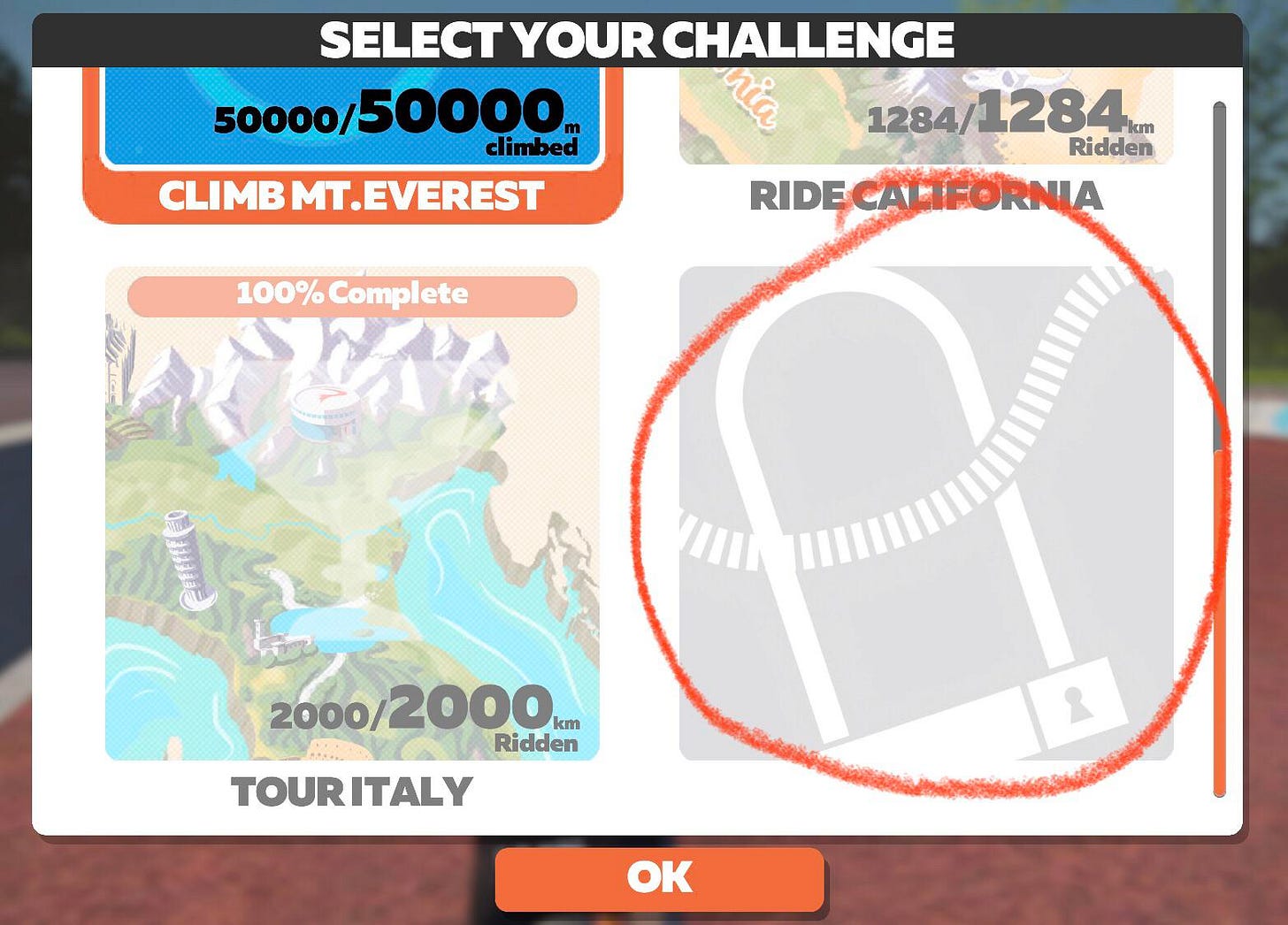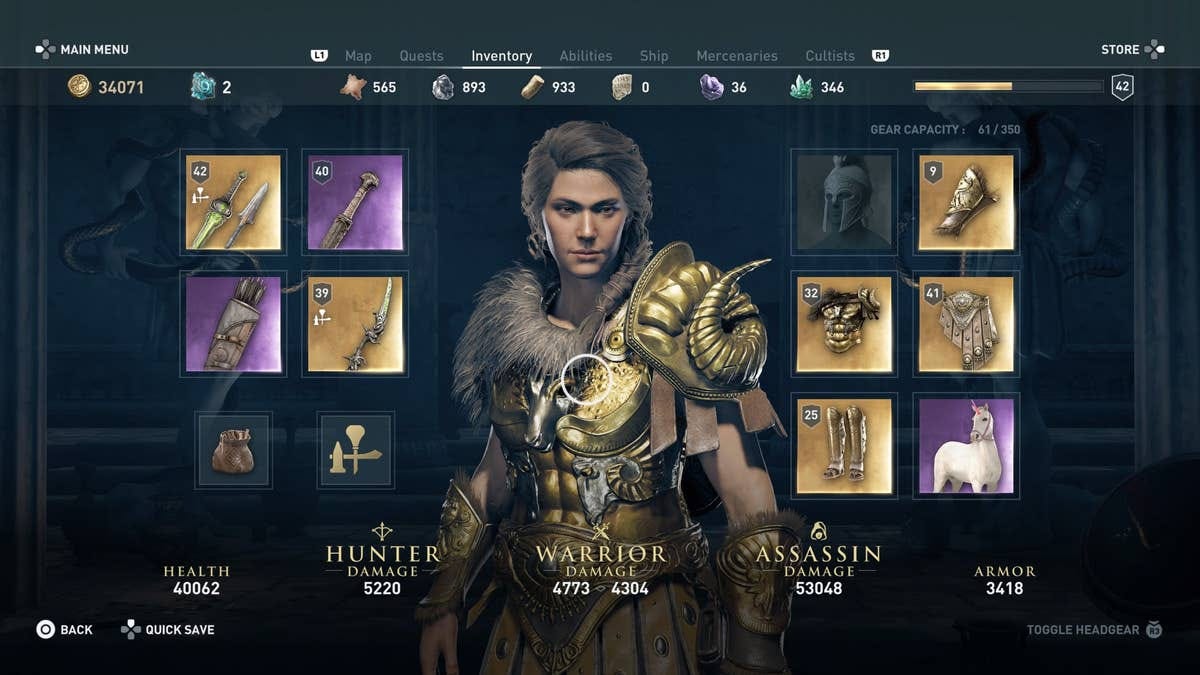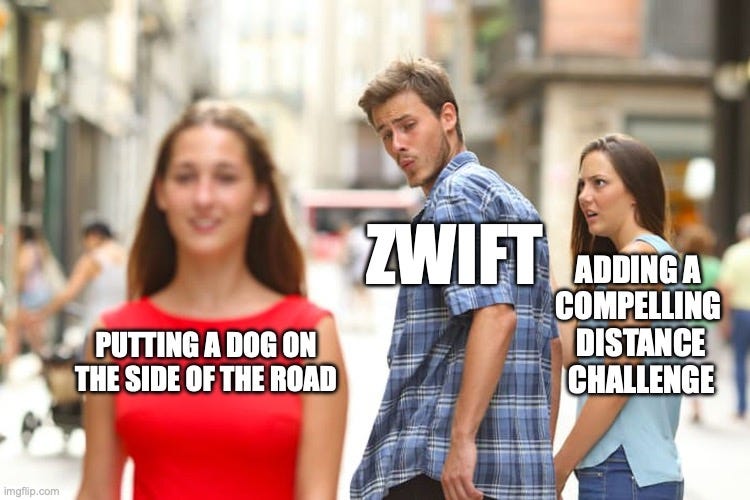Recess #6: Cycling Clear of the Uncanny Valley
Using the video game as inspiration to inform features for virtual workout platforms
Update 3/13/25: A reader informed me that Zwift just released their new completionism challenge for the first time in multiple years last week! I’ve left my commentary about my frustration in place to honor the years of waiting, but I need to get better at updating my apps…
The 2024 Game Awards (the current Oscars for video games) featured a wide range of categories ranging from best sound design to best art direction to best voice acting performance. Much like the Oscars, everyone was most eager to see the winner of the “Game of the Year” though— effectively a “Best Picture” analog. Somewhat surprisingly, at least on the surface, of the six nominees for Game of the Year, only two (Black Myth: Wukong & Final Fantasy VII) were really lauded for their graphical capabilities— more specifically their ability to look create photorealistic versions of a world and the characters within it. The other four nominees included an anime-styled game, a cartoon-y toy-like platforming game, and even a pixel-art card game.* As fate would have it, the cartoon style platforming game (Astrobot) won!
*You’ve got to try out Balatro if you’re looking for an addicting time-waster game that’s extremely fun to play.
Many times since the Game Awards I’ve used our bike trainer at home to hit an indoor cycling workout, and every time, I pop open an iPad and get the Zwift App fired up. For those who haven’t used it, Zwift is a virtual platform that simulates cycling terrain by modulating resistance on a trainer, and provides graphics and displays that allow the user to control their path around a virtual world (mainly “Watopia”). Zwift is effectively an interface for a piece of workout equipment, but it features an enormous amount of gamified features ranging from achievements to ongoing challenges to online racing.

Zwift is effectively a video game, even if your legs are serving as the controller instead of your hands (my preferred approach to gaming). Zwift also has some direct competitors within the gamified virtual cycling market like Rouvy, MyWhoosh just to name a couple. More broadly there’s a whole set of gamified workout platforms like Peloton or to some extent even Strava that have their own unique focuses and business models, but all could benefit from the lessons learned in the video game market about what generates staying power and provides stand out entertainment in a crowded market.
So despite the fact that this article was initially incepted to allow me to publicly gripe about Zwift, it’s turned into a summary of some key product features of great video games that virtual fitness companies like Zwift, and Peloton should take note of. Some of these, they already do well, but there’s always room for improvement, and there still might be a bit of griping along the way…
1. Abundant Side Quests
Everyone loves a good old fashioned side quest.
Especially in role-playing games (RPGs) like World of Warcraft and The Witcher 3, side quests always offer compelling reasons to keep exploring, either because they provide the gamer with a compelling story or an in-game reward. For me, side quests in games somehow often feel like less work and more enjoyable than progressing through the main story or features of a video game, and if you can establish a trust that the little extra time you spend with a game completing some slightly orthogonal task from your main goal is always worth spending, users will get locked into spending time with a game. For platforms like Zwift and Peloton, randomly-timed, structured mini-goals beyond simple distance or power or time challenges that push riders towards new experiences like sprint challenges might help break through the mental workout barrier and provide users a purpose beyond just burning calories. In general, I actually think that Zwift already does a pretty good job of this with all their one-off events, but there’s always room for improvement!
2. Front-and-center Completionism
Combine a long list of quests and goals with something as basic as a graphic that shows how much of a game or portions within it that you have completed, and you start to scratch the completionism itch for most people. There is nothing quite like “100%-ing” a game by uncovering every achievement in Spider Man or collecting every moon in Super Mario Odyssey, and I think fitness platforms should embrace this mentality with more meaningful milestones and perhaps more importantly clear communication about your completion level (to you and others)!
Zwift already has badge hunting and a handful of overall distance challenges, but could still add deeper layers—like unlocking a rare jersey for completing every climb in a region or earning a “Legendary Trainer” badge for consecutive months of consistency? For a real-world platform like Strava, you could show users what % of their town they’ve covered while running, or provide live visuals of their total distance and vert traversed year-to-date. Giving users a reason to keep coming back to finish up the last little bit of a challenge and being able to share that achievement can be a major factor in long-term audience engagement.

3. Intuitive User Interfaces
Great games balance depth with ease of use both while playing and navigating menus. Fortnite lets you build elaborate structures in seconds with an intuitive control scheme, while games like Mario Kart make menu navigation simple and fast. On the flip side, fitness platforms often overcomplicate their interfaces— either by adding too much information or failing to provide enough salience for key buttons and visuals. Zwift’s menus can feel clunky (especially when modifying workout power ranges), and Peloton’s navigation can overwhelm new users. Streamlining access to workouts, ride data, and challenges without burying them in submenus would make these platforms feel less like fitness or car software and more like modern video games and well-designed apps.
4. Using Realism as a Means, not an End
Many virtual fitness platforms like Zwift try to chase realism at the risk of missing key gameplay features or overall refinement, which is actually fairly common in the video game industry as well. However, somewhat counter-intuitively, the gaming industry has shown that hyper-realistic visuals don’t always make a game more fun to play: we don’t always want or need the most realistic game unless it serves a functional purpose. As a funny example, soccer video games like EA FC (previously FIFA) adds increasingly lifelike animations and graphics every year, yet players often complain that the game feels sluggish. Meanwhile, Rocket League, which involves driving rocket powered cars to play the sport of soccer barely resembles reality, and is honestly more fun to play, though the learning curve is quite steep.
Zwift seems to be pouring a lot of resources into making its worlds more immersive and realistic, especially in terms of graphics. Zwift’s focus on accurate physics can also sometimes make virtual cycling feel punishing rather than enjoyable. And both of these pursuits aren’t just limited to Zwift— one of their rivals in Rouvy uses actual videos from the real world and imposes virtual riders over them to show movement. This can be super exciting for pulling in famous routes and climbs, but doesn’t really enhance immersion relative to a Zwift-like platform. Instead of just mimicking the real world, these platforms should experiment with fantastical elements—imagine a gravity-reduced mountain climb race or spring challenges with jumps on the end that send your rider flying. I’d try those in a heartbeat!

5. In-depth Social Features
Multiplayer engagement is a major reason games like World of Warcraft and Call of Duty keep players invested, and an even bigger factor in the meteoric rise of video game streaming on platforms like Twitch. Zwift and Peloton already have group rides, and clubs, and in-game individual leaderboards, but the social experience can sometimes feels shallow. What if users could form teams with shared progression to unlock team-based achievements, or have scheduled “boss battles” like group endurance events where everyone contributes to beating a mega-distance goal? Again, I’d be very excited about these features and it might drag me back to Zwift more regularly.
Social collaboration in platforms like Zwift is quite lacking, and sharing your workout achievements is somewhat ironically shuttled through Strava for most athletes instead of being broadcast to a large audience on Zwift’s own interface (although this does happen and just requires a separate “Companion App” for most). However, Strava could also add more collaborative social features to enhance its product and keep users engaged beyond just the promotional challenges and social media aspects of their own platform!
6. Leaning into Unlockables & Collectables
Few things drive engagement quite like unlocking rewards. It’s what keeps the credit card industry moving, it’s why people love the McDonald’s Monopoly games on the drinks, and it makes games like Diablo and RuneScape insanely addictive. While Zwift and Peloton offer new jerseys and badges, their unlock systems often feel predictable and rewards don’t always feel like they are an enhancement over previous unlocks. Introducing randomized or surprise rewards like mystery gear drops for completing weekly challenges or during specific events might make workouts more exciting and unpredictable, though I’d be a bit hesitant to go as far as the loot box scheme of the video industry.
It would also be extremely fun to tie unlockables to specific completionism achievements, and for riders to more easily convey the rarity of the gear they are using could both keep people coming back for more.

7. Long-Term Engagement Strategies
Modern video games thrives on long-term retention strategies, with most “live-service” games like Apex Legends and Fortnite leveraging “seasons” that contain major overhauls to the game and platform. These larger changes to the play within the world, often accompanied by new visuals, quests, and tasks keep a game feeling fresh while maintaining past progress and familiarity. I think it would be awesome to see similar large-scale changes to platforms like Zwift over time to keep users excited about what’s to come while showing off their overall progress from the past. Whether these changes come annually, seasonally, or once every few years, they can really do a lot to make users believe their experience will keep improving.

The fusion of gaming and fitness is still in its early days, but the potential is clearly enormous, for both completely virtual platforms like Zwift and products that augment workouts in the real world like Strava. By co-opting additional mechanics from the video game industry, these products can continue to evolve beyond basic exercise tools into platforms with extremely high retention rates. Some company out there has the chance to create or morph into the League of Legends or the Pokémon Go! of the workout industry, and once that happens, there’s likely to be avalanche of similar offerings, which might be a bit overwhelming, but is ideally extremely useful for those looking for a fresh way to get healthy or go faster.
Who knows, maybe these companies will even end up testing out extremely unpopular NFT-based rewards at some point!
There’s the bell!






Loved this! One tidbit: there is now a new, fourth challenge! It's been years in the making, and everyone shared your frustration lol. See here though: https://zwiftinsider.com/factory-tour-challenge/